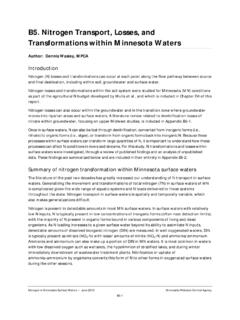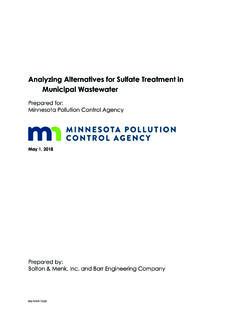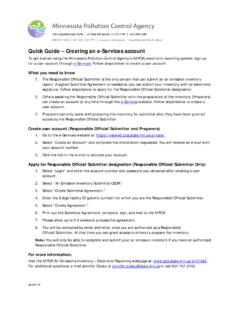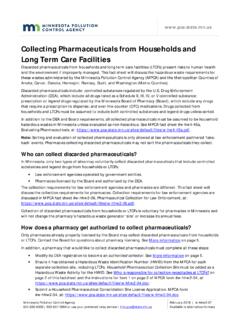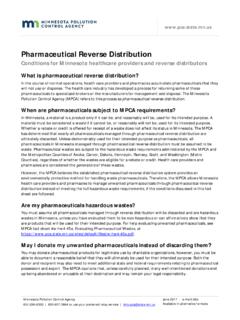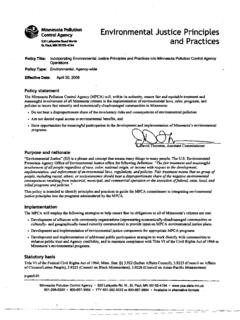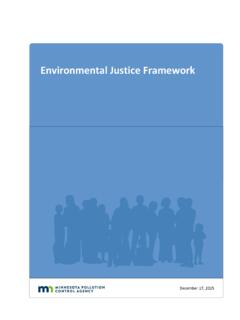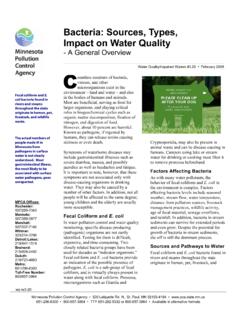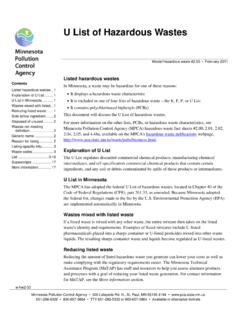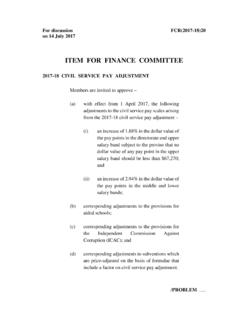Transcription of Developing Surface Water Nitrate Standards and …
1 Developing Surface Water Nitrate Standards and Strategies for Reducing Nitrogen LoadingIn response to a directive by the Minnesota Legislature to establish Water quality Standards for Nitrate -nitrogen and total nitrogen (2010 Session Laws, Chapter 361, Article 2, Section 4, Subdivision 1), the Minnesota Pollution Control Agency (MPCA) is leading two efforts: Developing Nitrate Water quality Standards for Surface waters based on aquatic life toxicity. Characterizing total nitrogen loading in watersheds throughout Minnesota to provide a foundation for Developing and evaluating nitrogen reduction strategies.
2 Nitrate Water Quality Standard Published research shows that Nitrate -nitrogen can be toxic to certain aquatic life at concentrations lower than values found in some Surface waters of the state. The MPCA has published draft Nitrate -nitrogen Water quality Standards to address aquatic life toxicity, as follows: Acute standard (maximum concentration at any time): o 41 mg/l Nitrate -N (draft for class 2 waters) Chronic standard (four day average concentration can not be exceeded more than once in a three year period): o mg/l Nitrate -N (draft for class 2A cold Water community) o mg/l Nitrate -N (draft for class 2B cool-warm Water community) Concern about Nitrate toxicity is based on information documented from the scientific literature, and from concerns raised by stakeholders and the Minnesota legislature.
3 Minnesota rules have an existing Nitrate standard for the protection of human health at 10 mg/L, which applies to Surface waters designated for drinking Water uses (class 2A and class 2Bd). The draft Nitrate aquatic life Standards were prepared based on toxicity tests reported in the scientific literature and from additional toxicity tests recently performed by the Environmental Protection Agency (EPA). These additional tests from EPA were important for MPCA s efforts to adequately determine the toxic effects of Nitrate to the full range of aquatic organisms.
4 The draft chronic Nitrate Standards to protect aquatic life are more restrictive than the existing human health value. The draft Nitrate Standards are one of several suggested revisions in the current triennial review of state Water quality Standards . The process for making changes is based on review of scientific data, consideration of relevant rules, guidance, public comments, and consultation with experts at the EPA and elsewhere. The MPCA developed a technical support document for the draft Nitrate Standards , located at MPCA staff will consider comments received, along with any new information as the Statement of Need and Reasonableness is developed.
5 The Water quality rule will be finalized in 2012. More information on the triennial Water quality rule review is found at: For further information on the Nitrate -N toxicity standard contact the MPCA s Water Assessment and Environmental Information Section at 800-657-3864 or December 2010 Minnesota Pollution Control Agency 520 Lafayette Rd. N., St. Paul, MN 55155-4194 651-296-6300 800-657-3864 TTY 651-282-5332 or 800-657-3864 Available in alternative formats Developing Surface Water Nitrate Standards and Strategies for Reducing Nitrogen Loading wq-s6-23 December 2010 Page 2 of 2 Total Nitrogen Loading Study Nitrate is a major component of total nitrogen, along with ammonium and organic nitrogen.
6 The MPCA is leading an ongoing study to characterize total nitrogen loading to Minnesota s Surface waters. The study will help provide a scientific foundation of information that will be used to develop and evaluate nitrogen reduction strategies for two separate purposes. This work will assist in Developing implementation strategies for Minnesota s Nitrate toxicity-based standard. Additionally, assessing where and why Nitrate loading is occurring in Minnesota streams, will assist in Developing a better strategy to address Minnesota s total nitrogen contributions to the Gulf of Mexico.
7 Nitrogen and phosphorus coming from the Mississippi River are causing algae blooms in the Gulf of Mexico, which leads to large areas of oxygen deprivation known as hypoxia. The MPCA, in conjunction with others, is working to characterize the following for Minnesota watersheds: 1. Watershed mass nitrogen loadings - assess how nitrogen loading to streams is geographically distributed in Minnesota. 2. Land uses and sources estimate mass loadings from different land uses/sources and assess which sources most influence nitrogen loading.
8 3. Hydrologic pathways assess the amount of nitrogen delivered to streams by groundwater baseflow, tile drainage, Surface runoff, atmospheric deposition, and other hydrologic pathways. 4. In-stream nitrogen losses and transformation evaluate how much nitrogen entering waters in one part of a state is delivered to downstream waters. 5. Temporal trends characterize stream nitrogen concentrations in the state and evaluate how in-stream nitrogen concentrations have changed during the past few decades. Building on existing information, the MPCA will use several approaches to accomplish the above.
9 Results from the different approaches and methods will be compared. 1. Watershed mass nitrogen loadings will be assessed through: a) watershed nitrogen budget calculations which account for nitrogen inputs and losses (University of Minnesota); b) computer modeling (SPARROW) for a typical flow year ( Geological Survey); and c) MPCA monitoring data of over 70 watersheds sampled between 2007 and 2009 (MPCA). 2. Land uses and sources will be evaluated using the same three information sources as the watershed mass nitrogen loadings assessment in #1.
10 Loading results from part , will be statistically compared with land use characteristics in the monitored watersheds. The MPCA will also conduct a separate point source assessment of nitrogen added by municipal and industrial facilities. All results will be compared with each other and to published findings assessing nitrogen loadings from different land uses and sources. 3. Hydrologic pathways for nitrogen loading to Surface waters will be assessed by the University of Minnesota as part of their watershed nitrogen budget calculations.
